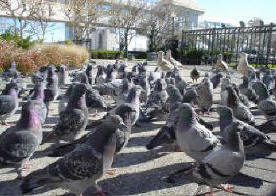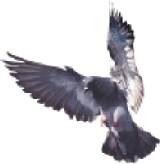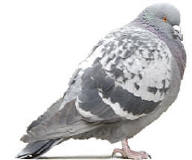 |
|
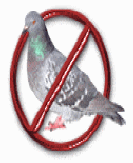 |
||||||
|
Home - About Us - Services - Birds - Bees - Wildlife - Products - Projects - Faq - PMP - Help - Links - Contact Us |
||||||||
|
Contact Arizona Wings N' Stings today at 602-942-6550 - 480-969-2337 to see about scheduling an inspection of your property and see how we can help you stop all the noise and mess as well as protecting you, your family, employees and customers from possible slip & fall dangers or health hazards associated with pest birds that are roosting or nesting in and around your home or business.
Height/Weight
Factoid: An average pigeon will poop 48 -51 times in a 24 hour period or more than 25 lb's of poop a year.
The most important part of any
pigeon or bird control program is making sure
they can't nest. There are no know products on the market or services that can guarantee 100% pigeons will not stand on an type of unprotected ledge or untreated surface. Bird control hazing systems work good for open air areas when no other type of bird control deterrent or exclusion product can be installed but not 100%
|
Pigeon Sparrow Swallow Starling Woodpecker Crow Grackles
Feral Pigeon Biology and Control Information
Feral pigeons (Columbia livia) are the number one urban pest bird, causing damage where ever they nest or roost. Pigeons are descendants of domesticated European homing pigeons or Rock Doves, so they have a varied diet and feel at ease making their homes in man-made structures. Generally blue-grey in color, with iridescent feathers on the head and neck, pigeons often have markings in black, white or brown on the wings and neck. A short neck and small head characterize the standard pigeon; their short legs, hind toes and level front allow for both easy perching on pipes and ledges or walking on flat surfaces. Pigeons generally nest in small, flat areas away from the ground such as building ledges, air conditioning units or window sills.
A pigeon can go, if necessary, a long time without food or even water. Most birds need a constant water source and that they will visit every day. Pigeons are skilled in finding water and food sources, and rarely have trouble finding a source in the city. Individual pigeons can have a home range of 150 miles, although most will stay close to home, which is generally considerably less than 25 miles or so. If their food and water sources change drastically, however, they will migrate, to another spot, near or far, with better provisions. Damage caused by Pigeon Problems Nesting materials and other debris has caused failures in machinery, especially rooftop air conditioning units which are a prime nesting spot for pigeons. Other frequent pigeon problems include slip and fall liability from feces or debris, plus an unclean, dirty company image is presented when pigeons are roosting all over a building or store front sign. The bacteria, fungal agents
and ectoparasites found in pigeon droppings are responsible for a host of
serious diseases, including histoplasmosis, encephalitis, salmonella,
meningitis, toxoplasmosis and more.
FLYING RATS ? 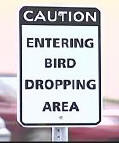 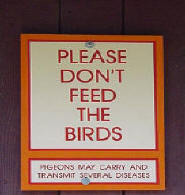 Pigeons
also become habituated to humans, by being extensively fed by
humans, as in outdoor eating restaurants, parks and schools which only
aggravates the problem. Pigeons, domesticated for hundreds of years, are
easily tamed and handled by humans. It is important to note that NO wild
animals, including wild pigeons, should be fed, at any time, for any
reason, by anyone. Pigeons
also become habituated to humans, by being extensively fed by
humans, as in outdoor eating restaurants, parks and schools which only
aggravates the problem. Pigeons, domesticated for hundreds of years, are
easily tamed and handled by humans. It is important to note that NO wild
animals, including wild pigeons, should be fed, at any time, for any
reason, by anyone.
Pigeon Control Products TOXICANTS AND POISONS Both are used exactly the same way, by pre-baiting with ordinary feed corn or seed for 5 - 7 days and then when the pigeons or birds are accepting the bait readily, the corn is laced with the toxicant and doled out to the pigeons when the birds eat the treated bait the birds have a reaction, some act loopy and many die or get very sick. Then the process can be started again with pre-baiting for 5 - 7 days etc.. This process is very labor intensive if it is done correctly and according to label directions a service person must stay around and pick up dead and dying birds then remove any remaining treated bait so protected birds don't get into the bait. Unfortunately most of the time we see a Pest Control Technician putting a pie tin or something on a roof top, put in the bait and leaving the bait there all month long which will only make the birds that survive shy away from the corn. In most cases baiting when done right the affected pigeons die. No matter what kind of story some technician will give you, these bait products do not make the pigeons forget where they live, act like BIRDIE LSD, or make the pigeons act crazy and fly away, it is designed to kill many of them. We do not use poison baits like Avitrol for any type of bird. Live Trapping is a much more effective and humane solution for population reduction. These products all act as a poison to birds since they are flock reduction products and you carry the added liability of having a poisoned bird dropping into someone's yard where the dog or cat can eat the baited bird and possibly get sick or worse yet die - Then who do you think your neighbors will be looking for to sue $$$ SOME UNUSUAL PIGEON FACTS
Trying to discover or prevent pigeons from returning home, researchers have tried to confuse them in every way possible. By transporting them to a remote location: In the dark, in randomly rotating cages, with strong or weak magnetic fields, with flashing lights, and even anesthetized, or any combinations of these, (and others too) nothing seemed to affect their navigation skills, even in unfamiliar territories. Pigeons are suspected of using magnetic structures already known to be in their brains, but there was still no change in their ability, even when tiny, removable magnets were attached to their heads, supposedly to confuse these structures.
RACING PIGEONS
|
|||||||
|
Copyright © 2009 Arizona Wings-N-Stings All rights reserved. Revised: 06/05/12. |
||||||||
| Website by JAK | ||||||||


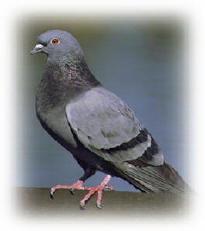 Most of the pigeons you
see around a city, building, bridge, billboard or
other structure, are pigeons that were born and raised
close by. A few may be "vagrants" and constantly on the move, but most of them
are going to be your neighborhood pigeons that will be nesting and breeding near
to where you see them if food and water is close by.
Most of the pigeons you
see around a city, building, bridge, billboard or
other structure, are pigeons that were born and raised
close by. A few may be "vagrants" and constantly on the move, but most of them
are going to be your neighborhood pigeons that will be nesting and breeding near
to where you see them if food and water is close by. 